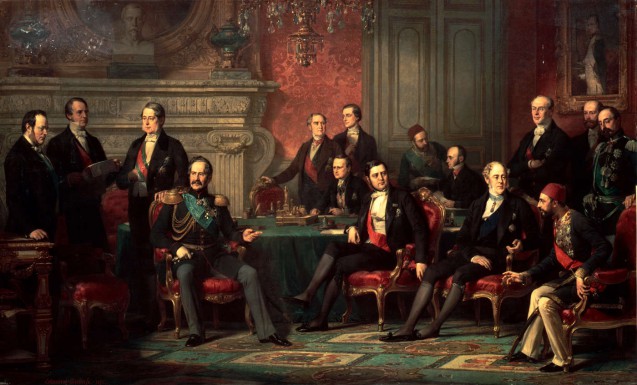Édouard-Louis Dubufe was the son of the painter Claude-Marie-Paul Dubufe and a student of Jacques-Louis David. When this painting was commissioned for Versailles, Dubufe had already produced famous portraits such as that of the dramatic actress Rachel in 1850 and the portrait of the Empress Eugenie in 1854.
A highly political picture
The painting commemorated the international conference that concluded the Crimean War, in which France alongside Great Britain was victorious against Russia. Such a large political painterly subject was a challenge for this official painter, who was more accustomed to intimate compositions. Not only was it of considerable size, furthermore all the participants had to be shown in the appropriate order according to the protocol. The plenipotentiary ministers of the countries involved – Austria, France, Great Britain, Russia, Sardinia, and Turkey as well as Prussia who, despite its non-participation in the conflict, was invited to participate in the discussions for all but the first session out of consideration for Concert of Europe) – are all shown according to their rank, from left to right: Cavour (Sardinia), Cowley (Great Britain), Buol-Schauenstein (Austria), Orlov (Russia); in the background, Bourqueney (France), Hübner (Austria), Manteuffel (Prussia), Walewski (French Foreign Minister as chairman), Mehemmed Djemil Bey (Ottoman Empire), Benedetti (France, responsible for the drafting of protocols), Clarendon (Great Britain) and Mehmed Emin Aali Pasha (Ottoman Empire).
Dubufe presented the work at the Salon of 1857, which devoted an entire room to the Crimean War; the photograph here shows that the painting was in prime position. Napoleon III is represented on the canvas by a bust on the mantelpiece of the Quai d’Orsay salon (which has since been renamed “Salon du Congrès”). Napoleon I is also represent through a 1838 portrait by Delaroche hanging on the right. As well as reminding us of the blood ties between the two sovereigns, this reminder of the First Empire invites the comparison between this event and the Congress of Vienna in 1815. Indeed Dubufe’s composition imitates that of Isabey’s masterful “Congress of Vienna” in the arrangement of the table and figures around it and even by the portraits of the two French Emperors that match those of Francis I and Marie-Thérèse in Isabey’s work.
And the Concert of Europe was indeed central to the negotiations in both 1815 and 1856. But France had been the pariah at the Congress of Vienna. That meeting had aimed at the reconstruction of Europe in the aftermath of Napoleon I in the face of France. Here, the Congress of Paris was requested by Napoleon III, who had just defeated Russia, thereby revenging defeat of the Grande Armée in 1812 and which had brought about the fall of Napoleon I. In multiplying the references to Napoleon I and the Congress of Vienna, Dubufe is effectively positioning Napoleon III as the successor who repairs the offences made to France fifty years earlier, and even improves – respectfully – the situation of the Empire which he has inherited.
The Congress of Paris, “A diplomatic Spring”* (Yves Bruley)
In 1856, Napoleon III had invested himself with a kind of moral authority over Europe. He had curbed Russia’s ambitions for expansion in the non-frozen waters of the Black Sea but had not sought to humiliate the Tsar. Yves Bruley underlines the originality of this international meeting: “What was at stake in Paris in the spring of 1856, was the capacity of representatives of the European powers to invent a multilateral diplomacy that was not only able to process technical issues or settle occasional crises, but capable of dealing with the main problems of Europe and the world”. Since Russia has already accepted the neutrality of the Black Sea, and the independence and integrity of the Ottoman Empire (who agreed to protect Christians in return), the Congress could focus on something other than the tributes of war. Even the thorny Italian question, which had initially been set aside, would be addressed (during a single session) in April.
One of the major successes of this event was the creation of Romania (the principalities of Moldavia and Wallachia had to be consulted on their willingness to be united in a state independent of Russia, Austria and the Ottoman Empire). Other subjects which had not been included in the congress program, were also discussed, namely: the problematic Bessarabia/Caucasus border between Russia and the Ottoman Empire; free navigation on the Danube; and, at the suggestion of the French, the revision of maritime law in time of war. The Congress finished early (on 18 March), and the peace it enshrined was to last until 1859 when the Italian question resurfaced. This painting therefore illustrates one of the greatest diplomatic victories of the Second Empire.
A sketch of this painting has can be seen as part of the permanent exhibition of the Musée de l’Armée (Paris) since February 2014.
Marie de Bruchard, January 2016 (translation R. Young)
* La diplomatie du Sphinx, Yves Bruley, CLD Éditions, 2015 (in French)


